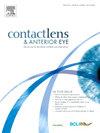Gabor patches training programme for neuroadaptation in multifocal contact lenses wearers
IF 3.7
3区 医学
Q1 OPHTHALMOLOGY
引用次数: 0
Abstract
Objectives
To evaluate the effect of using a training programme (OPTIcTRAIN) using Gabor patches on visual performance during the fitting of multifocal contact lenses (CL) in neophyte wearers.
Methods
A randomized longitudinal pilot study was conducted at the Optometry Clinic of Complutense University of Madrid (Spain). Participants were fitted with Comfilcon A multifocal CL and randomly assigned to either a Gabor group (receiving daily training) or a control group. Measurements were taken at baseline (V0), CL fitting day (V1) and after 10 (V2) and 20 days (V3) of CL wear, assessing visual acuity (VA) under different conditions (photopic and mesopic, high (HC) and low contrast (LC)) at far, intermediate and near distances, contrast sensitivity, and subjective measures using visual analogue scale and global rate changing scale (GRCS).
Results
Twelve subjects (10 females, 2 males; mean age: 51.41 ± 5.41 years) were included. After 20 days, the Gabor group showed significantly higher HCVA (p = 0.016) and LCVA (p = 0.034) under photopic conditions at intermediate distances (−0.03 ± 0.05, 0.11 ± 0.09, respectively) compared to the control group (0.08 ± 0.07, 0.26 ± 0.10, respectively). No significant differences (p > 0.05) were observed between groups in VA under mesopic conditions. Contrast sensitivity did not significantly differ between groups at any visit. However, after 20 days, the Gabor group’s contrast sensitivity (6 cpg) increased to values similar to baseline (V0: 6.33 ± 0.81 vs V1: 5.17 ± 0.75; p = 0.038; V1 vs V3: 6.00 ± 0.89, p = 0.025), whereas the control group experienced a significant decrease (V0: 6.50 ± 0.54 vs V1: 5.83 ± 0.75; p = 0.046). After 20 days, the Gabor group showed a significant improvement in halo perception (p = 0.043) on the GRCS (44.00 ± 4.04) compared to the control group (26.67 ± 7.47).
Conclusions
A visual training program using Gabor patches may enhance high and low-contrast VA at intermediate distances under photopic conditions, improve contrast sensitivity for medium spatial frequencies, and enhance subjective perception of halos during initial adaptation to multifocal CL in presbyopic wearers.
多焦点隐形眼镜佩戴者Gabor贴片神经适应训练方案。
目的:评估使用Gabor贴片的培训计划(OPTIcTRAIN)对新手配戴多焦隐形眼镜(CL)期间视力表现的影响。方法:在马德里康普顿斯大学验光诊所(西班牙)进行了一项随机纵向试点研究。参与者配备了Comfilcon A多焦CL,并随机分配到Gabor组(接受日常训练)或对照组。在基线(V0)、CL配戴日(V1)、CL配戴10 (V2)和20 (V3)后进行测量,评估远、中、近距离不同条件下(光、介观、高对比度(HC)和低对比度(LC))的视力、对比敏感度,并采用视觉模拟量表和全局变化率量表(GRCS)进行主观测量。结果:12例受试者(女性10例,男性2例;平均年龄:51.41±5.41岁)。20 d后,Gabor组在中距离光照条件下(分别为-0.03±0.05,0.11±0.09)的HCVA (p = 0.016)和LCVA (p = 0.034)显著高于对照组(分别为0.08±0.07,0.26±0.10)。中观条件下各组间VA无显著差异(p < 0.05)。在任何访问中,对比敏感度在两组之间没有显着差异。然而,20天后,Gabor组的对比敏感度(6 cpg)增加到与基线相似的值(V0: 6.33±0.81 vs V1: 5.17±0.75;p = 0.038;V1 vs V3: 6.00±0.89,p = 0.025),而对照组则显著降低(V0: 6.50±0.54 vs V1: 5.83±0.75;p = 0.046)。20 d后,Gabor组GRCS评分(44.00±4.04)较对照组(26.67±7.47)有显著改善(p = 0.043)。结论:使用Gabor贴片的视觉训练计划可以增强在光敏条件下中距离的高对比度和低对比度VA,提高中空间频率的对比度灵敏度,并增强老花眼配戴者在初始适应多焦CL时对晕的主观感知。
本文章由计算机程序翻译,如有差异,请以英文原文为准。
求助全文
约1分钟内获得全文
求助全文
来源期刊

Contact Lens & Anterior Eye
OPHTHALMOLOGY-
CiteScore
7.60
自引率
18.80%
发文量
198
审稿时长
55 days
期刊介绍:
Contact Lens & Anterior Eye is a research-based journal covering all aspects of contact lens theory and practice, including original articles on invention and innovations, as well as the regular features of: Case Reports; Literary Reviews; Editorials; Instrumentation and Techniques and Dates of Professional Meetings.
 求助内容:
求助内容: 应助结果提醒方式:
应助结果提醒方式:


